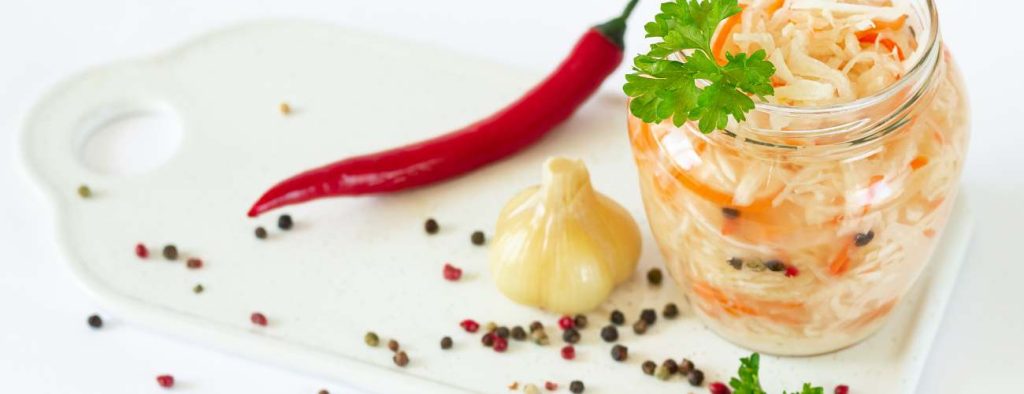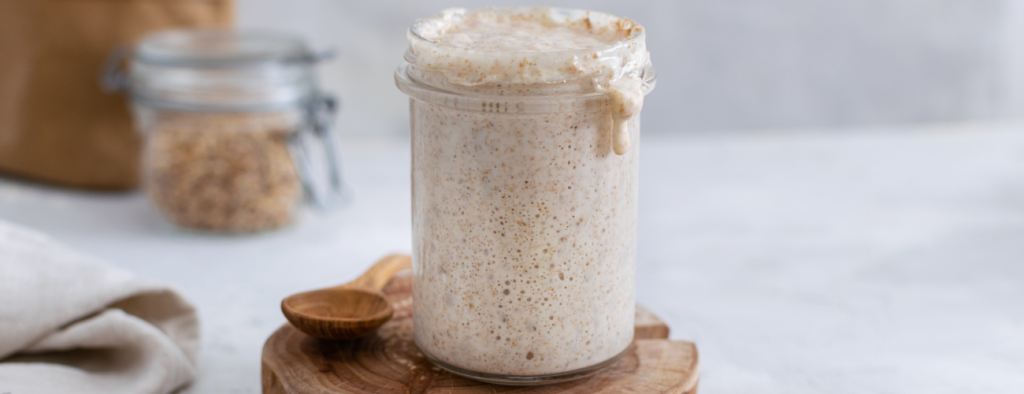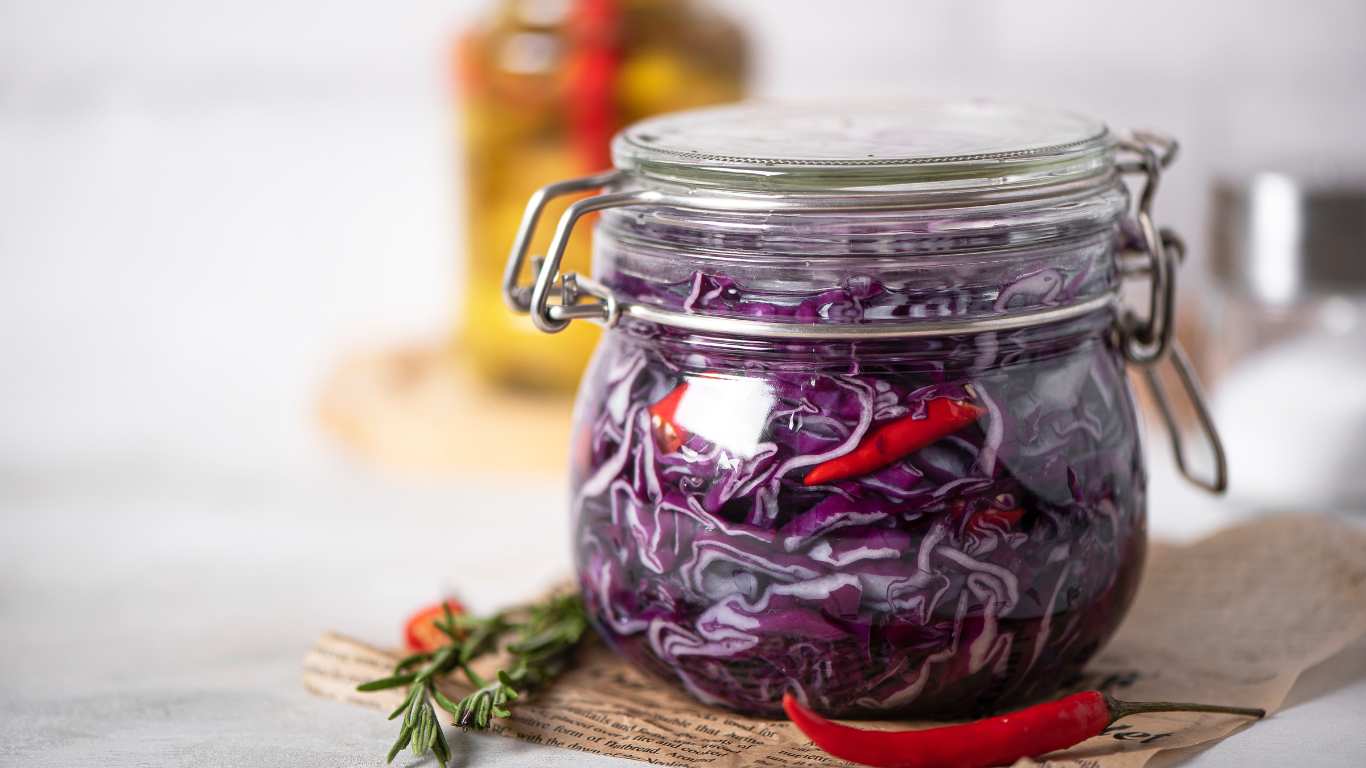Adding spices to your ferments can indeed enhance the flavour. However, you might be hesitant to do so, worrying that this will discourage the fermentation process. In this blog, I am going to discuss whether you should be mindful of adding spices to your ferments.
Spices themselves generally do not inhibit fermentation; in fact, many traditional fermented foods, such as kimchi and sauerkraut, include various spices for flavour. However, the antimicrobial properties of some spices such as garlic, ginger, and hot peppers might slow down or alter the fermentation process.
Are you wondering how? Carry on reading if you would like to learn more.
Can Spices Inhibit Fermentation?
As already mentioned, certain spices, such as garlic, ginger, cloves, turmeric, oregano and hot peppers, are known to have antimicrobial properties. While these properties can help prevent the growth of harmful bacteria, they may also inhibit the growth of beneficial lactic acid bacteria responsible for the fermentation process. In some cases, this can slow down or alter the fermentation.
It’s interesting that, despite their antimicrobial characteristic, these spices are actually used quite successfully in lots of fermented dishes.
Take one of my favourites – pickles. Whether made from cucumbers, beets, or other veggies, also use a mix of dill, garlic, mustard seeds, and black peppercorns to give them taste while preserving them.
People who love hot sauce know that a mix of hot peppers, garlic, onions, and salt not only brings the heat but also creates complex flavours. Fermented salsas do something similar, with cilantro, cumin, garlic, and jalapeños adding a zesty touch.

It’s important to note that the impact of spices on fermentation can vary depending on the type and concentration of spices used, as well as the specific microorganisms involved in the fermentation. Additionally, the inhibitory effects of spices may be more pronounced in the initial stages of fermentation when the microbial populations are still establishing themselves.
In my experience, finding a solution for those concerned about the potential impact of spices on fermentation involves a careful approach. If you share this concern, consider experimenting with different spice quantities or introducing them later in the fermentation process to minimize any inhibitory effects. It’s crucial to add the right amount of salt – typically around 2% of the overall weight. Adding too little or too much salt can inhibit fermentation. From my trials, I’ve learned that the use of salt in fermentation is pivotal. It not only fosters an environment conducive to the growth of beneficial bacteria but also acts as a delicate balance, inhibiting the growth of undesirable microorganisms
While some spices may have antimicrobial properties that could influence fermentation, their impact depends on various factors, and many traditional fermented foods successfully incorporate spices for flavour without significantly hindering the fermentation process.
Commonly used spices and their potential impact on fermentation:
| Spice | Antimicrobial Properties | Commonly Used In Fermentation For Flavour | Potential Impact on Fermentation |
| Garlic | Yes | Yes | Excessive use may impact fermentation. |
| Ginger | Yes | Yes | Excessive amounts may influence fermentation. |
| Hot Peppers | Yes | Yes | Excessive use may impact overall microbial balance. |
| Cloves | Yes | Yes | Excessive use may inhibit the growth of certain microorganisms. |
| Turmeric | Yes | Yes | Excessive use may influence fermentation dynamics. |
| Oregano | Yes | Yes | Excessive use may impact microbial activity. |
| Cinnamon | Yes | Yes | Use in moderation to avoid potential inhibition of fermentation. |
| Mustard Seeds | Mild | Yes | Mild antimicrobial properties may play a role in fermentation. |
| Coriander | Yes | Yes | Adds flavour and possesses antimicrobial qualities. |
| Cumin | Yes | Yes | Excessive use might impact the microbial balance. |
| Allspice | Yes | Yes | Used in some traditional ferment recipes. |
| Black Pepper | Mild | Yes | Contributes to the overall microbial environment in ferments. |
If you would like to learn more about fermentation , I would encourage you to read my blog which explores if you can ferment anything.
What Problems Could Hinder the Fermentation Process?
Several factors can inhibit or negatively impact the fermentation process. Here are some common elements that may hinder or slow down fermentation:
1. High Salt Content:
As already mentioned, excessive salt in the fermentation brine can inhibit the growth of beneficial lactic acid bacteria, affecting the overall fermentation process. It’s essential to use the appropriate salt concentration according to the specific fermentation recipe.
2. High Sugar Levels:
While sugar is often a necessary component for fermentation, excessively high sugar levels can create an environment that is unfavourable for certain microorganisms. It can lead to osmotic stress, hindering microbial activity.
3. Extreme Temperatures:
Fermentation is a temperature-sensitive process. Extremely high or low temperatures can impact the activity of fermentation microorganisms. For example, temperatures that are too high may kill or deactivate the microbes, while very low temperatures can slow down their metabolic processes.
4. Preservatives and Additives:
Some commercial products may contain preservatives or additives that can inhibit the growth of microorganisms. When attempting fermentation, it’s advisable to use fresh and natural ingredients without added chemicals.
5. Lack of Oxygen (Anaerobic Conditions):
In certain types of fermentation, such as lactic acid fermentation, the absence of oxygen (anaerobic conditions) is crucial. Introducing oxygen into the environment may hinder the growth of the desired microorganisms.
6. Contamination:
Unwanted microbes, moulds, or bacteria from the environment can contaminate the fermentation process. It’s crucial to maintain a clean and sanitized environment to prevent unwanted microorganisms from affecting the fermentation.
7. Metal Containers:
Fermentation can be inhibited by metal containers, especially those made of reactive metals like aluminium or copper. These metals can react with acids produced during fermentation, affecting the flavour and safety of the final product.
8. Chlorinated Water:
Water containing high levels of chlorine or chloramine can inhibit the growth of beneficial bacteria. It’s recommended to use dechlorinated water for fermenting to avoid interference with microbial activity.
9. Chemical Residues:
Residues from cleaning agents or sanitizers, if not thoroughly rinsed, can negatively impact fermentation. It’s essential to ensure that equipment is properly cleaned and rinsed to avoid introducing unwanted chemicals.
10. Unbalanced Nutrient Levels:
Microorganisms involved in fermentation require specific nutrients. An imbalance of nutrients, such as inadequate or excessive amounts of nitrogen, phosphorus, or other essential elements, can affect microbial growth and fermentation outcomes.
When engaging in fermentation, careful attention to these factors, adherence to recipes, and maintaining optimal conditions are crucial for achieving successful and flavourful results. Experimentation is encouraged, but understanding the impact of these elements on fermentation is essential for consistent and desirable outcomes.
How Do I Know If My Fermentation is Going Well?
Monitoring the progress of your fermentation is crucial to ensure its success. Here are some signs that indicate your fermentation is going well:
1. Bubbling and Gas Release:
In many fermentations, especially those involving yeast or lactic acid bacteria, you’ll observe bubbling and the release of gas (usually carbon dioxide). This is a positive sign that fermentation is active.

2. Expansion of the Fermentation Vessel:
If you are using an airtight container, you may notice that the vessel becomes pressurized or expands slightly. This indicates the production of gases during fermentation.
3. Change in Colour and Aroma:
Fermenting foods often undergo changes in colour and develop distinctive aromas. For example, vegetables might change hues, and the smell may shift from raw to a more complex, fermented fragrance.
4. Taste Testing:
Periodically tasting your ferment allows you to assess its progress. As fermentation proceeds, flavours will evolve, and the taste should move from the initial raw ingredients to a more developed, tangy, or complex profile.
5. Presence of Sediment:
Depending on the type of fermentation, you may notice the accumulation of sediment at the bottom of the container. This is normal and can indicate microbial activity.
6. Maintaining Desired Temperature:
Check that your fermentation is occurring within the recommended temperature range specified in your recipe. Maintaining consistent temperatures helps support microbial activity.
7. Observing the Brine:
In vegetable fermentations, such as sauerkraut or pickles, observe the clarity and color of the brine. Cloudiness and changes in color are typical signs of active fermentation.
8. Lactic Acid Production:
In lacto-fermentation, the production of lactic acid contributes to the tangy taste. Taste the liquid; if it has a pleasing acidity, your fermentation is likely progressing well.
9. Mould-Free Surface:
Ensure that the surface of your ferment is free from mould. Mould growth can indicate contamination and is not a typical part of the fermentation process.
10. Timing Matches Recipe Guidelines:
Refer to the recommended fermentation time in your recipe. If the duration aligns with the recipe guidelines and you observe positive signs, your fermentation is likely on track.
It’s important to note that the absence of certain signs doesn’t necessarily mean a failed fermentation. Some ferments are less visibly active, and individual recipes may exhibit different characteristics. Additionally, factors such as temperature, ingredient variations, and specific strains of microorganisms can influence the appearance and pace of fermentation. Regular observation, tasting, and a bit of patience will help you determine whether your fermentation is progressing as expected.



